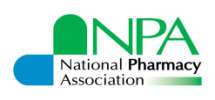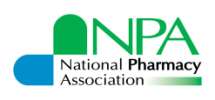Slide




Common dispensing errors and how
to avoid?




Objectives
• Highlight common dispensing errors which occur in community
pharmacies and learn from these
• Identify how the NPA can support you in the event of a dispensing
• Help you to improve patient safety, by adopting procedures within
the pharmacy which promote good dispensing practices
• Explain error reporting requirements • Discuss NPA's role as Medication Safety Officer for independents
and how errors can be reported through the NPA
• Help you to identify and manage risks
Dispensing errors
Leyla Hannbeck MSc. MPharm
Head of Pharmacy Services
Definitions
Medication error - an incident in which there has been an
error in the process of:
o prescribing o dispensing o preparing o administering o monitoring, or providing
medicine advice regardless of whether any harm occurred
• Near miss - an incident that did not cause harm but
which is judged to have had the potential to cause harm
Causes of errors
1. Prescription errors
! Misreading the prescription
! Illegible handwriting
! Abbreviations ambiguous or misinterpreted
! Pharmacist unfamiliar with Latin abbreviations
! Units of measurement ambiguous or misinterpreted
! Incorrect calculations
Can you read these prescriptions?
ondansetron or candesartan?
2. Dispensing errors
! Medicines with similar names
! Medicines with similar packaging
! Incorrect picking of the medicine
! Transposing the label or labelling the medicine
! Dispensing out-of-date medicine
! Not dispensing against the prescription
! Incorrect labelling
Similar name
Similar packaging
3. Other causes
• Busy workplace • Stress • Distractions • Staff shortages • Giving the wrong medicine to
the wrong patient
• Omitting medicines • Lack of concentration • Lack of clinical knowledge
High risk medicines
• May cause serious patient harm if dispensed incorrectly:
o Narrow therapeutic range o Serious adverse effects if dose or administration
!Opioid medicines
!Oral anti-cancer medicines
• NPA Standard Operating Procedures for dispensing
certain high risk medicines following guidance issued by the NPSA
How to minimise dispensing errors
Important to have a
clutter free and
organised dispensing
Keep interruptions
in dispensary to a
Only allow competent
pharmacy staff to put
away dispensary stock
Maintain workload of
pharmacy staff at safe and manageable level
Dispensing process
Verify name of medicine if unclear or badly written Clarify unclear or illegible doses before dispensing Check abbreviations of medicine names or dosage units Print dispensing label before selecting medicine from shelf Use prescription to select stock, not dispensing labels or patient
medication record (PMR)
Alert staff to medicines with similar names and packaging
Dispensing process
Involve two people in dispensing
process where possible
Make final accuracy check against the
Calculations should be written down
and double-checked
Pharmacist should take a short mental
break between assembly and final check if working alone
Procedure should be in place to identify
who was involved in dispensing and checking processes
Patient identity must be confirmed
before prescriptions are handed over
Clinical assessment of a
1. Check that the medicine is not contraindicated or should
be used with caution in specific patient groups, such as: o Children o Elderly patients o Pregnant or breastfeeding women o Immunocompromised patients o Patients of certain ethnic backgrounds o Female/male patients
Clinical assessment of a
o Interactions o Potential side effects o Dosage, form and route of administration o Duration of treatment o Other medical conditions o Monitoring requirements
Final accuracy check
For each item, check: Name on bulk pack or patient pack matches prescription Strength of item against strength on prescription Multiple packs are the same medicine and the same
Expiry date Drug form of medicine against drug form on prescription Quantity on prescription against dispensed medicine Dispensed medicine against contents of bulk pack Patient information leaflet is supplied
Final accuracy check
Check prescription against label for :
Patient name Name of medicine Strength Quantity Dosage form Dose/instructions
Check label against product Mark ‘checked by' box
Near miss incidents
• Dispensing mistakes can
Types of near miss
be minimised if near
• Incorrect drug
misses are regularly
• Out of date product
reviewed and actions
• Incorrect form
• Incorrect label
Ensure that all staff can access the near miss log
• Item not given to
patient/representative
• The NPA ‘Near miss
• Prescription misread
register' is available from
• Incorrect quantity
• Incorrect strength
Dealing with a dispensing error
• Provide patient/representative and patient's GP with any required
information immediately if patient has been harmed
• Inform patient/representative that a thorough investigation will be conducted
and an action plan prepared to minimise the risk of re-occurrence
• If patient has taken any of the incorrect medicine, ascertain whether they
have been harmed
• Always inform patient's GP if an incorrect medicine has been taken
Dealing with a dispensing error
• Apologise to the patient/representative • Supply the correct medicine, if appropriate • Ascertain the patient's/representative's expectations • Carry out a root cause analysis • Follow pharmacy procedures for reporting the incident • Record, review and learn from the error(s) made
Root cause analysis
o What happened o How o Why
• Putting into place
recommendations should reduce chance of incident recurring
• Focuses on system that has
gone wrong rather than the individual who has made the error
Patient safety alerts
• Medicines & Healthcare products Regulatory Agency
(MHRA) may issue advice, often in conjunction with
manufacturers
• Information also in Drug safety Updates• Sale of products may change
• European Medicines Agency (EMA) is responsible for
European marketing authorisations and may issue advice
• Marketing authorisation (MA) holders may issue
guidance, such as new dosing recommendations or contraindications
Dealing with patient safety alerts
• Pharmacists need to be aware of any alerts or guidance
issued and take appropriate action
• When patient safety alerts are received, pharmacists
Implement all the actions relevant to them Ensure all relevant staff are aware of the information
and/or required changes
Where appropriate, contact doctors or refer patients
to doctors to discuss treatment
Keeping up to date with patient
safety alerts
Sign up to NPA alerts Check the NPA website Sign-up to information email alerts from
Sign-up to email alerts from the Central
Check the European Agency website Ensure the fax machine is always
switched on and contains paper
Medication Safety Officer (MSO)
• NPA's Head of Pharmacy Services is MSO for all
independent community pharmacies in England with fewer than 50 branches
• Responsibilities include:
o Promoting safe use of medicines o Implementing local and national medications safety
o Improving patient safety o Submitting medication error reports to National Reporting
and Learning Systems (NRLS)
o Improving reporting and learning from medication
o Responding to requests from NHS England and the
MHRA for further information about medication errors
MSO page on NPA website
• Dedicated Patient Safety/MSO page on NPA website -
o Patient Safety Incident Report Form o SOPs for high risk medicines o Patient Safety Alert Factsheet o Patient Safety Alert Audit Sheet o Recent patient safety alerts and news stories
MSO page on NPA website
Patient Safety Incident Report Form
• Easy and quick to use,
• NPA forwards information
with tick boxes and drop
(anonymously) to NHS
England – no need for
• Can print off copy for
pharmacy to submit
pharmacy use – useful for
separate report to NRLS
• Feedback has been good
• Patient information is not
• More members are using
seen by NPA – pharmacy
adds this by hand after
• Guidance notes on
completing the form are
Common errors being reported
• Types of error:
o wrong drug/medicine – 33% of reported errors o wrong dose or strength - 24% of reported errors
• Examples of wrong drug/medicine:
o Seretide instead of Serevent o Novomix instead of Novorapid o Chlorpromazine instead of chlorphenamine
• Important factors – for those reports which ticked any:
o 71% ticked "medicines with similar looking or sounding
o 14% ticked "poor labelling and packaging"
Contributing factors
• For reports that identified contributing factors, 56% selected
"Work and environment factors"
• This category includes poor/excess administration, physical
environment, work load, hours of work and time pressures
o Examples reported:
o "self dispensing and checking, workload and not
o "busy time of the day" o "busy, main dispenser off"
Dispensing errors
Glyn Walduck, FCILEx
NPA Insurance – what is on offer?
Insurance across the spectrum for members, pharmacists, families and those working in pharmacy practice
e.g. PI, PL, legal defence to GI for shops, homes and personal lines
What we insure you for.
Breach of your professional duty – all amounts you are legally liable to pay as compensation and costs for claims made against you for breach of professional duty caused by negligence or omission and costs
Public liability – damages and costs in the event of accidental injury or death of any person and/or accidental damage to another persons property caused by your negligence or omission and costs
Product liability – damages and costs for injury or death or accidental damage to another persons property caused by the retail sale or supply of products and costs
What we insure you for.
4. Legal expenses: •
Against prosecution for an offence arising from the conduct of the retail pharmacy business
Legal expenses resulting from the representation by legal or other expert at Coroner's Inquests and other Fatal Accident Inquiries
Legal expenses incurred in responding to a GPhC investigation and representation by a legal or other expert at Fitness to Practise hearings (Disciplinary/Health) up to a maximum of £5,000 plus VAT
Who is covered?
• Members • Employees • Self-employed persons who are engaged by
members e.g. locum
What's it all about?
• NPA Insurance Professional Indemnity Cover • NPA Member Support
Holistic approach and added value
What happens when it all goes
Responding to complaints
The Letter:
How to write it (Tip: Who ‘s overlooking my shoulder)
Communicate findings
Risk management/steps taken to prevent repetition – revisiting SOPs and amending if need be
Parliamentary and Health Service Ombudsman
Beware of Standard Template Letters
- Goodwill gestures •
Quadruple jeopardy
- Police CPS - Police Service NI - Procurator Fiscal - Coroner - GPhC - NHS
Your NPA and NPAI Working Together To
support, protect & represent
• Managing the press • Liaising with Pharmacy Services on ethical and competency issues • Feeding into consultations with policy e.g. Medicines Rebalancing Legislation and Sanctions guidance • Managing Risk with Professional Development - Delivery Driver Course
When it all goes wrong
• Indemnity • Defence • Advice • Assistance
• NPA Insurance Ltd • NPA Members PI Insurer
Upcoming NPA Events
www.npa.co.uk/events
Source: http://npatrans.test.webnarrative.co.uk/wp-content/uploads/2015/11/Common-dispensing-errors-webinar.pdf
> Accueil > Actualité > Le magazine > Troubles obsessionnels compulsifs Actualité Le magazine Troubles obsessionnels compulsifs La vie est un " enfer " pour 2 à 3 % des Français atteints de Les Urgences troubles obsessionnels compulsifs (Toc), maladie loin d'être rare
8.8. Mo 19:00 @Alte Synagoge Erfurt (Waagegasse 8) Bobe Mayses – Yiddish Knights and Other Impossibilities Theaterperformance/Theater Performance Eintritt/Admission: 14,50 €/8,50 € In Koproduktion mit dem Kunstfest Weimar bringt der Yiddish Summer ein neues Theaterstück nach Erfurt, das sich mit der mittelalterlich-jüdischen Geschichte der Stadt auseinandersetzt: Bobe Mayses – Yiddish Knights and Other Impossibilities, geschrieben vom New York Times-Bestsel erautor









